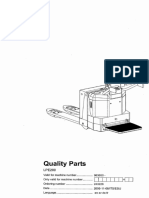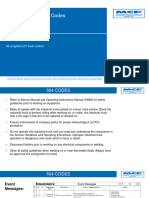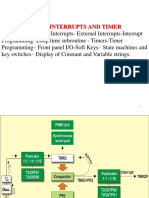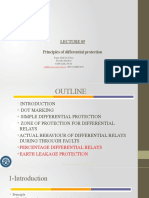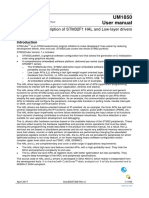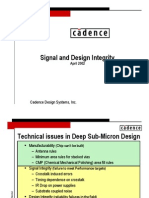Zapi Error Codes
Uploaded by
iqbal.revivalZapi Error Codes
Uploaded by
iqbal.revival9.
14
The ALARMS logbook in the MAIN MENU records the alarms occurred on the
controller. It has a FIFO (First Input First Output) structure which means that the
oldest alarm is lost when the database is full and a new alarm occurs. The
logbook is composed of locations where is possible to stack different types of
alarms with the following informations:
1) The alarm code;
2) The number of times that each alarm occurs consecutively;
3) The Hour Meter value when the last event of every alarm occurred;
4) The inverter temperature at the first occurrence of every alarm.
This function permits a deeper diagnosis of problems as the recent history can be
revised.
For simple visual diagnosis of system faults and to monitor system status, a red
LED is provided on the body of the controller. It is ON at the start-up and then it
stays continuously OFF when there is no fault; when there is a fault it flashes
several times, with a repeated pattern that identifies a specific alarm (see
paragraph 6.7).
NOTE: if the same alarm is continuously happening, the controller does not use
new memory of the logbook, but only updates the last memory cell increasing the
related counter (point 2) of previous list). Nevertheless, the hourmeter indicated
in this memory refers to the first time the alarm occurred. In this way, comparing
this hourmeter with the controller hourmeter, it is possible to determine:
- When this alarm occurred the first time.
- How many hours are elapsed from the first occurrence to now.
- How many times it has occurred in this period.
AF6ZP0CA COMBIAC0-ACE0 2uC - User Manual Page - 107/160
10 FAULTS DIAGNOSTIC SYSTEM
The fault diagnostic system of ACE4 controller is divided into 2 main groups of
faults:
ALARMS: these are the faults which open the power section, which means that
the power bridge is opened and, when possible, the LC is opened and EB is
applied. These are faults related to:
- failures in the motor/controller that prevent the power system to drive the
truck;
- safety related failures.
WARNINGS: these are faults that do not stop the truck or they will stop it with a
controlled regenerative braking. In other words, the controller is working well, but
it has detected conditions that require to reduce the performances or to stop the
truck without opening the power stage. These warnings are related to:
- wrong operator sequences;
- .
10.1 Microcontroller Master alarms overview
Indication
Machine status
Error Restart
Effect When the test is CAN
Code procedure MDI ZAPI LED
done OPEN
CODE CODE CODE
CODE
MC is not
closed, Valves or
VDC LINK
EB is applied, Stand-by, running Traction/Pump 0XFFCA 77 202 77
OVERV.
Traction/Pump, Request
valves stopped
MC is opened,
HOME EB is applied, Running Key re-cycle 0xFFB0 3 176 3
SENS.ERR XX
EVP stopped
MC is not
closed,
IMS ERROR EB is applied, Start-up Key re-cycle 0XFFA7 4 167 4
Traction/Pump,
valves stopped
MC is not
closed, Valves or
SHORT Traction/Pump
EB is applied, Running 0xFFA6 5 166 5
CIRCUIT
Traction/Pump, Request
valves stopped
MC is not
closed,
SHORT
EB is applied, Start-up, stand-by Key re-cycle 0xFFA5 5 165 5
CIRCUIT KO
Traction/Pump,
valves stopped
MC is not
closed,
PWM
EB is applied, Start-up Key re-cycle 0xFFA4 6 164 6
ACQ.ERROR
Traction/Pump,
valves stopped
MC is opened,
EB is applied,
WATCHDOG Start-up, stand-by, running Key re-cycle 0x6010 8 8 8
Traction/Pump,
valves stopped
Page - 108/160 AF6ZP0CA COMBIAC0-ACE0 2uC - User Manual
Indication
Machine status
Error Restart
Effect When the test is CAN
Code procedure MDI ZAPI LED
done OPEN
CODE CODE CODE
CODE
MC is closed
EVP DRIV. or opened , EB Traction/
EVP off 0x5003 9 215 9
SHORT. is applied, Pump request
EVP stopped
MC is not
closed, Install the
CONTROLLER correct
EB is applied, Start-up 0xFFEF 12 239 12
MISM. software and
Traction/Pump,
Key re-cycle
valves stopped
MC is not
closed, Valves or
SEAT
EB is applied, Start-up, stand-by, running Traction/ 0xFFDE 15 222 15
MISMATCH
Traction/Pump Pump request
stopped
MC is not
closed, Valves or
LOGIC
EB is applied, Stand-by, running Traction/Pump 0x5114 19 19 19
FAILURE #1
Traction/Pump, Request
valves stopped
MC is not
closed, Valves or
LOGIC Traction/Pump
EB is applied, Start-up, stand-by, 0XFF12 18 18 18
FAILURE #2
Traction/Pump, Request
valves stopped
MC is not
closed, Valves or
LOGIC Traction/Pump
EB is applied, Start-up, stand-by 0XFF11 17 17 17
FAILURE #3
Traction/Pump, Request
valves stopped
MC is not
closed, Valves or
LC COIL Traction/Pump
EB is applied, Start-up, stand-by, running 0xFFE6 22 230 22
OPEN
Traction/Pump, Request
valves stopped
Valves or
IQ Traction is
Running Traction/Pump 0xFFF5 24 245 24
MISMATCHED stopped
Request
INIT VMN
LOW 01 MC is not
closed,
INIT VMN
EB is applied, Start-up Key re-cycle 0x3121 30 207 30
LOW 02
Traction/Pump,
INIT VMN
valves stopped
LOW 03
INIT VMN
HIGH 81 MC is not
closed,
INIT VMN
EB is applied, Start-up Key re-cycle 0x3111 31 206 31
HIGH 82
Traction/Pump,
INIT VMN
valves stopped
HIGH 83
MC is not
closed, Valves or
VMN HIGH EB is applied, Start-up, stand-by Traction/Pump 0x3110 31 31 31
Traction/Pump, Request
valves stopped
MC is not
closed, Valves or
VMN LOW EB is applied, Start-up Traction/Pump 0x3120 30 30 30
Traction/Pump, Request
valves stopped
AF6ZP0CA COMBIAC0-ACE0 2uC - User Manual Page - 109/160
Indication
Machine status
Error Restart
Effect When the test is CAN
Code procedure MDI ZAPI LED
done OPEN
CODE CODE CODE
CODE
MC is not
HW FAULT 11 closed,
HW FAULT 12 EB is applied, Start-up Key re-cycle 0xFFE3 32 227 32
HW FAULT 13 Traction/Pump
stopped
MC is not
HW FAULT 01 closed,
HW FAULT 02 EB is applied, Start-up Key re-cycle 0xFFE3 32 227 32
HW FAULT 03 Traction/Pump
stopped
MC is not
closed,
POSITIVE LC
EB is applied, Start-up, stand-by, running Key re-cycle 0xFFD5 35 213 35
OPEN
Traction/Pump,
valves stopped
MC is opened,
Valves or
FIELD EB is applied,
Running Traction/Pump 0xFFFD 36 253 36
ORIENT KO Traction/Pump,
valves stopped Request
MC is not
closed
(command is Valves or
CONTACTOR not activated), Start-up Traction/Pump 0x5442 37 37 37
CLOSED
EB is applied, Request
Traction/Pump
stopped
MC is opened,
Valves or
CONTACTOR EB is applied, Start-up, stand-by, running Traction/Pump 0x5441 38 38 38
OPEN Traction/Pump,
valves stopped Request
Traction is
POWER stopped Traction/
EB is applied, Running Pump request 0xFFD4 39 212 39
MISMATCH
MC is opened
MC is not The alarms
closed, disappears as
WRONG SET soon as the
EB is applied, Start-up 0x3100 41 251 41
BAT voltage comes
Traction/Pump, back into the
valves stopped correct range
MOT.PHASE
SH.36 MC is not
closed,
MOT.PHASE Traction/
EB is applied, Start-up 0xFFC4 47 196 47
SH.37 Pump request
Traction/Pump,
MOT.PHASE valves stopped
SH.38
MC is not
closed, Valves or
STBY I HIGH EB is applied, Start-up, stand-by Traction/Pump 0x2311 53 53 53
Traction/Pump Request
stopped
Traction is
OVERLOAD Running Key re-cycle 0xFFB4 57 180 57
stopped
MC is not
closed, Valves or
CAPACITOR
EB is applied, Start-up Traction/Pump 0x3130 60 60 60
CHARGE
Traction/Pump, Request
valves stopped
Traction Valves or
TILLER Traction/Pump
stopped, Eb Stand-by, running 0xFFB9 64 185 64
ERROR
applied Request
Page - 110/160 AF6ZP0CA COMBIAC0-ACE0 2uC - User Manual
Indication
Machine status
Error Restart
Effect When the test is CAN
Code procedure MDI ZAPI LED
done OPEN
CODE CODE CODE
CODE
MC is opened,
EB is applied, Valves or
NO CAN MSG. Start-up, stand-by, running Traction/Pump 0X8130 67 248 67
Traction/Pump,
valves stopped Request
MC is opened,
WRONG RAM EB is applied,
Stand-by Key re-cycle 0xFFD2 71 210 71
MEM. Traction/Pump,
valves stopped
MC is opened
(the command
Valves or
DRIVER is released),
Start-up, stand-by, running Traction/Pump 0x3211 74 74 74
SHORTED EB is applied,
Traction/Pump, Request
valves stopped
MC is opened
(the command
Valves or
CONTACTOR is released),
Start-up, stand-by, running Traction/Pump 0x3221 75 75 75
DRIVER EB is applied,
Traction/Pump, Request
valves stopped
MC is opened,
Valves or
MC-EF COIL EB is applied, Start-up (immediately after MC Traction/Pump 0x2250 76 223 76
SHOR. Traction/Pump, closing), stand-by, running
Request
valves stopped
MC is opened ,
SPEED FB. EB is applied, Running Key re-cycle 0xFFAF 81 175 81
ERROR
EVP stopped
MC is opened,
Valves or
ENCODER EB is applied,
Running Traction/Pump 0xFF52 82 82 82
ERROR Traction/Pump,
Request
valves stopped
MC is not
closed,
WRONG ENC
EB is applied, Start-up Key re-cycle 0xFF51 83 181 83
SET
Traction/Pump,
valves stopped
MC is opened,
ANALOG EB is applied, Stand-by, running Key re-cycle 0xFFFA 96 237 96
INPUT traction/pump
stopped
MC is opened
(the command
Valves or
CTRAP is released),
Start-up, stand-by, running Traction/Pump 0xFFEB 99 235 99
THRESHOLD EB is applied,
Traction/Pump, Request
valves stopped
MC is opened,
AUX BATT. EB is applied, Running Key re-cycle 0x5001 27 194 27
SHORT traction/pump
stopped
MC is not
closed,
POS. EB.
EB is applied, Start-up Key re-cycle 0x3223 84 195 84
SHORTED
Traction/Pump,
valves stopped
MC is opened,
VDC OFF EB is applied, Start-up, stand-by, running Key re-cycle 0xFFC8 88 200 88
SHORTED traction/pump
stopped
AF6ZP0CA COMBIAC0-ACE0 2uC - User Manual Page - 111/160
Indication
Machine status
Error Restart
Effect When the test is CAN
Code procedure MDI ZAPI LED
done OPEN
CODE CODE CODE
CODE
MC is opened,
VKEY OFF EB is applied, Start-up, stand-by, running Key re-cycle 0x5101 20 220 20
SHORTED traction/pump
stopped
MC is opened,
POWERMOS EB is applied, Start-up Key re-cycle 0xFFE9 89 233 89
SHORTED traction/pump
stopped
MC is opened,
Valves or
BUMPER EB is applied, Stand-by, running Traction/Pump 0xFFA2 0 162 0
STOP traction/pump
stopped Request
MC is not
closed,
WRONG SET
EB is applied, Start-up, stand-by, running Key re-cycle 0x3101 41 170 41
KEY
Traction/Pump,
valves stopped
MC is not
closed,
WRONG SET
EB is applied, Start-up, stand-by, running Key re-cycle 0x3100 41 251 41
BATTERY
Traction/Pump,
valves stopped
10.2 Analysis and troubleshooting of alarms displayed on console
(Master)
1) VDC LINK OVERV.
Cause:
This fault is displayed when the controller detects an over voltage condition.
Over voltage threshold is 35V for 24V controller, 65V for 36/48V controller
and 116V for 80V controller.
As soon as the condition occurs the power bridge and the MC are opened.
The condition is triggered using the same HW interrupt used for undervoltage
detection; the uC discerns between the two conditions evaluating the voltage
present on capacitors bank:
- High voltage -> Overvoltage condition
- Low/normal voltage Undervoltage condition
Troubleshooting:
If the alarm happens during the brake release, check the line contactor
contact and the battery power cable connection.
2) LOGIC FAILURE #1
Cause:
This fault is displayed when the controller detects an under voltage condition
on key input pin (A1 (A3)).
The under voltage threshold is 11V in the 24V and 36/48V controller. In 80V
controller the under voltage threshold is 30V.
Troubleshooting when this fault is displayed at startup or in standby:
- It can be caused by a key input signal characterized by down-going
Page - 112/160 AF6ZP0CA COMBIAC0-ACE0 2uC - User Manual
pulses (below under voltage threshold) due to external loads, like
DC/DC converters at the start-up, relays or contactor during switching
periods, solenoids that are energizing / de-energizing themselves.
- If no voltage transient is detected on the supply line and the alarm is
present every time the key is switched ON, the failure is probably in the
hardware section of the controller, so it is necessary to replace the logic
board.
Troubleshooting of fault displayed during motor driving:
- If the alarm happens during motor acceleration or when there is a
request of hydraulic functions, check the battery charge condition and
the power cable connection.
3) LOGIC FAILURE #2
Cause:
Fault in the hardware section of the logic board which manages the motor
voltage feedback.
Troubleshooting:
This type of fault is not related to external components, so when it happens it
is necessary to replace the Controller.
4) LOGIC FAILURE #3
Cause:
Hardware problem in the logic card circuit for high current (overload)
protection. An overcurrent condition is triggered even if the power bridge is
not driven.
Troubleshooting:
This type of fault is not related to external components, so, when it is present
it is necessary to replace the logic board.
5) POSITIVE LC OPEN
Cause:
The voltage feedback of LC driver (A12) is different than expected.
Troubleshooting:
- Verify that the coil is connected correctly.
- CONF. POSITIVE
with the actual coil positive supply (see paragraph 8.2.6 ). The software,
in fact, depending by specific parameter value, makes a proper
diagnosis; a wrong configuration of the parameter could generate a false
fault.
- In case no failures/problems have been found, the problem is in the
controller, which has to be replaced.
6) CTRAP THRESHOLD
Cause:
This alarm occurs when the threshold related to the overcurrent detection
circuit is different than expected. The goal of this diagnosis is to detect a
mismatch between the threshold set point (dependent by dedicated
parameter PWM Ctrap, see paragraph 0) and the actual value.
AF6ZP0CA COMBIAC0-ACE0 2uC - User Manual Page - 113/160
Troubleshooting:
If the problem occurs permanently it is necessary to substitute logic board.
7) WATCH DOG
Cause:
This is a safety related test. It is a self-diagnosis test that involves the logic
between
Master and Supervisor microcontrollers.
Troubleshooting:
This alarm could be caused by a CANBus malfunctioning, which blinds
master-supervisor communication.
8) WRONG RAM MEM. 05
Cause:
The algorithm implemented to check the main RAM registers finds wrong
s the machine operations.
Troubleshooting:
Try to switch the key off and then on, if the alarm is still present replace the
logic board.
9) TILLER ERROR
Cause:
Input mismatch between Hard&Soft input (A6) and tiller input (A1): the two
inputs are activated at the same time.
Troubleshooting:
- Check if there are wrong connections in the external wiring.
- Using the
sees in input is in accordance with the actual state of the external switch
inputs.
- Check if there is a short circuit between A6 and A1
- In case no failures/problems have been found, the problem is in the
controller, which has to be replaced.
10) OVERLOAD
Cause:
The motor current has overcome the limit fixed by hardware.
Troubleshooting:
Reset the alarms by Key re-cycling.
If the alarms condition occurs again ask for assistance to a Zapi technician.
The fault condition could be affected by a wrong adjustment of motor
parameters.
11) FIELD ORIENT. KO
Cause:
The error between the Id set point and the estimated Id is out of range.
Troubleshooting:
Ask for assistance to a Zapi technician in order to do the correct adjustment
of the motor parameters.
Page - 114/160 AF6ZP0CA COMBIAC0-ACE0 2uC - User Manual
12) IQ MISMATCHED
Cause:
The error between the Iq set point and the estimated Iq is out of range.
Troubleshooting:
Ask for assistance to a Zapi technician in order to do the correct adjustment
of the motor parameters.
13) EVP DRIV. SHORT.
Cause:
- The EVP driver is shorted (output A23).
- The microcontroller detects a mismatch between the valve set-point
value stored in the memory and the driver voltage measured on the EVP
output.
Troubleshooting:
- Check if there is a short or a low impedance between the negative of the
coil and -BATT.
- Collect information about:
the voltage applied across the EVP coil;
current in the coil;
Characteristics of the coil.
Ask for assistance to Zapi in order to verify that the software diagnosis are in
accordance with the type of coil.
- If the problem is not solved it could be necessary to replace the
controller.
14) CAPACITOR CHARGE
It is related to the charging capacitor system:
Cause:
When the key is switched ON, the inverter tries to charge the power
capacitors through a series of a PTC and a power resistance, and check if
the capacitor are charged within a certain timeout. If the capacitor voltage
measured is less than 20% of the nominal battery voltage, an alarm is raised;
the main contactor will remain open.
Troubleshooting:
- There is an external load in parallel to the capacitor bank, which sinks
current from the capacitors pre-charging circuit, thus preventing the caps
from charging. Check if a lamp or a dc/dc converter or an auxiliary load is
AF6ZP0CA COMBIAC0-ACE0 2uC - User Manual Page - 115/160
placed in parallel to the capacitor bank.
- The charging resistance or PTC is opened; insert a power resistance
across line contactor power terminals; if the alarm disappears, it means
that the controller internal charging resistance is damaged.
- The charging circuit has a failure, inside the controller.
- There is a problem in the controller power section.
15) MOT.PHASE SH.
Cause:
Short circuit between two motor phases. The number that follows the alarm
identifies where the short circuit is located:
- 36 short circuit U-V
- 37 short circuit U-W
- 38 short circuit V-W
Troubleshooting:
- Verify the motor phases connection on motor side
- Verify the motor phases connection on inverter side
- Check the motor power cables.
- Sub ar the problem is in
the motor. Replace it.
16) INIT VMN LOW 01/02/03
Cause:
Before switching the LC on, the software checks the power bridge voltage
without driving it.
The software expects that the voltage is in
If it is too low, this alarm occurs.
Troubleshooting:
Please check:
- Motor power cables connections;
- Impedance between motor power phase columns and -Batt (in the
- Motor leakage to truck frame;
- If the motor connections are OK and there are no external low
impedance paths, the problem is inside the controller. Replace it
17) INIT VMN HIGH 81/82/83
Cause:
Before switching the LC on, the software checks the power bridge voltage
without driving it.
The software expects that the voltage is in
If it is too high, this alarm occurs.
Troubleshooting:
Please check:
- Motor power cables connections;
- Impedance between motor power phase columns and +Batt (in the
- Motor leakage to truck frame;
- If the motor connections are OK and there are no external low
impedance paths, the problem is inside the controller. Replace it.
Page - 116/160 AF6ZP0CA COMBIAC0-ACE0 2uC - User Manual
18) VMN LOW
Cause 1:
Start-up test. Before switching the LC on, the software checks the power
bridge: it turns on alternatively the High side Power Mosfets and expects the
phases voltage increases toward the rail capacitor value. If the phases
voltage is less than 66% of the rail capacitor voltage, this alarm occurs.
Cause 2:
Motor running test. When the motor is running, power bridge is ON and the
motor voltage feedback is tested; if it is lower than expected value (a window
of values are considered), the controller enters in fault status.
Troubleshooting:
- If the problem occurs at start up (the LC does not close at all), check:
Motor internal connections (ohmic continuity);
Motor power cables connections;
If the motor connections are OK, the problem is inside the controller,
replace it.
- If the alarm occurs during motor running, check:
Motor connections;
That the LC power contact closes properly, with a good contact;
If no problem is found, the problem is inside the controller, replace it.
19) VMN HIGH
Cause 1:
Before switching the LC on, the software checks the power bridge: it turns on
alternatively the Low side Power Mosfets and expects the phases voltages
decrease down to -BATT. If the phases voltages are higher than 10% of
nominal battery voltage, this alarm occurs.
Cause 2:
This alarm may occur also when the start-up diagnosis is overcome, and so
the LC is closed. In this condition, the phases voltages are expected to be
lower than 1/2 VBATT. If it is higher than that value, the controller enters in
fault status.
Troubleshooting:
- If the problem occurs at start up (the LC does not close at all), check:
Motor internal connections (ohmic continuity);
Motor power cables connections;
If the motor connections are OK, the problem is inside the controller,
replace it.
- If the alarm occurs while the motor is running, check:
Motor connections;
That the LC power contact closes properly, with a good contact;
If no problem is found, the problem is inside the controller, replace it.
20) HW FAULT 11/12/13
Cause:
The controller checks at each start-up that the hardware
circuit intended to enable and disable the Main contactor driver
(A16(A26))works properly.
Troubleshooting:
This type of fault is not related to external components, so, when it is present
AF6ZP0CA COMBIAC0-ACE0 2uC - User Manual Page - 117/160
it is necessary to replace the logic board.
21) HW FAULT 01/02/03
Cause:
The controller Supervisor uC checks at each start-up that the hardware
circuit for enabling and disabling of Power Bridge works properly.
Troubleshooting:
This type of fault is not related to external components, so, when it is present
it is necessary to replace the logic board.
22) POWER MISMATCH
Cause:
The error between the Power set point and the estimated Power is out of
range.
Troubleshooting:
Ask for the assistance to a Zapi technician to do the correct adjustment of the
motor parameters.
23) SEAT MISMATCH
Cause:
This alarm can appear only in a Traction + Pump configuration.
There is an input mismatch between Traction controller and Pump controller
relatively to the seat input: the two values recorded by traction and pump are
different.
Troubleshooting:
- Check if there are wrong connections in the external wiring.
-
controllers see an input value that is in accordance with the actual state
of the external switch input.
- In case no failures/problems have been found, the problem is in the
controller, which has to be replaced.
24) STBY I HIGH
Cause:
The current sensor or the current feedback circuit is damaged in the
controller. The sensor detects a current value different than zero.
Troubleshooting:
This type of fault is not related to external components so, when it is present,
it is necessary to replace the controller.
25) CONTROLLER MISM.
Cause:
The software is not compatible with the Hardware. Each controller produced
eeprom according to the customized Part Number.
Accor , only the customized firmwares can be uploaded.
Troubleshooting:
- Upload the correct firmware.
- Ask for assistance to a Zapi technician in order to verify that the firmware
is correct.
Page - 118/160 AF6ZP0CA COMBIAC0-ACE0 2uC - User Manual
26) ENCODER ERROR
Cause:
This fault is signaled in following conditions: the frequency supplied to the
motor is higher than 40 Hz and the signal feedback from the encoder has a
jump higher than 40 Hz in few tens of msec. This condition is related to an
encoder failure.
Troubleshooting:
- Check both the electric and the mechanical functionality of the encoder,
the wires crimping.
- Check the mechanical installation of the encoder, if the encoder slips
inside its housing it will raise this alarm condition.
- Also the electromagnetic noise on the sensor can be a cause for the
alarm. In these cases try to replace the encoder.
- If the problem is still present after replacing the encoder, the failure is in
the controller.
27) SPEED FB. ERROR
Cause:
This alarm appears if the absolute position sensor is used also for speed
estimation. If signaled, it means that the controller measured that the engine
was moving too quick.
Troubleshooting:
- Check that the sensor used is compatible with the software release.
- Check the sensor mechanical installation and if it works properly.
- Also the electromagnetic noise on the sensor can be a cause for the
alarm.
- If no problem is found on the motor or on the speed sensor, the problem
is inside the controller, it is necessary to replace the logic board.
28) WRONG ENC SET
Cause:
Mismatch between ENCODER PULSES 1 parameter and ENCODER
PULSES 2 parameter (see paragraph 8.2.6).
Troubleshooting:
Set the right parameters
29) CONTACTOR CLOSED
Cause:
Before driving the MC coil, the controller checks if the contactor is stuck. The
controller drives the power bridge for several dozens of milliseconds, trying to
discharge the capacitors bank. If the capacitor voltage does decrease by
more than 20% of the key voltage, the alarm is generated.
Troubleshooting:
It is suggested to verify the power contacts of LC; if they are stuck, is
necessary to replace the LC.
30) CONTACTOR OPEN
Cause:
The main contactor coil has been driven by the controller, but it seems that
the power contacts aren closing.
In order to detect this condition the controller injects a DC current into the
motor and checks the voltage on power capacitor. If the power capacitor are
AF6ZP0CA COMBIAC0-ACE0 2uC - User Manual Page - 119/160
going to be discharged it means that the main contactor is open.
Troubleshooting:
- It could be a problem of the contacts in the LC that are not working (the
LC did not lift them), try replacing the LC.
- If the contactors of LC are working correctly contact a Zapi technician.
31) CONTACTOR DRIVER
Cause:
The MC coil driver is not able to drive the load. The device itself or its driver
circuit is damaged.
Troubleshooting:
This type of fault is not related to external components; replace the logic
board.
32) LC COIL OPEN
Cause:
This fault appears when no load is connected between the NLC output (A16
(A26)) and the positive voltage(for example +KEY).
Troubleshooting:
- It is suggested to check the wiring harness, in order to verify if LC coil is
connected to the right connector pin and if it is not interrupted.
- If, even connecting the coil to the right pin or by replacing it the alarm is
still present, than the problem is inside the controller logic board, replace
it.
33) MC-EF COIL SHOR.
Cause:
This alarm occurs when there is an overload of the MC driver (A16 (A26))
and EB driver (A17 (A27)). As soon as the overload condition disappears, the
alarm will be removed automatically by releasing and then enabling a travel
demand.
Troubleshooting:
- The typical root cause is in the wiring harness or in the load coil. So the
very first check to carry out concerns the connections between the
controller outputs and the loads.
- Collect information about characteristics of the coils connected to the two
drivers and ask for assistance to a Zapi technician in order to verify that
the maximum current that can be supplied by the hardware is not
exceeded.
- In case no failures/problems have been found, the problem is in the
controller, which has to be replaced.
34) ANALOG INPUT
Cause:
This alarm occurs when the A/D conversion of the analog inputs returns
frozen values, on all the converted signals, for more than 400msec. The goal
of this diagnosis is to detect a failure of the A/D converter or a problem in the
code flow that skips the refresh of the analog signal conversion.
Troubleshooting:
If the problem occurs permanently it is necessary to substitute the logic
board.
Page - 120/160 AF6ZP0CA COMBIAC0-ACE0 2uC - User Manual
35) DRIVER SHORTED
Cause:
The driver of the main contactor coil is shorted.
Troubleshooting:
- Check if there is a short or a low impedance pull-down between NLC
(A16 (A26)) and BATT.
- The driver circuit of the logic board is damaged, and it has to be
replaced.
36) POWER ACQ. ERROR
Cause:
This alarm occurs only when the controller is configured to drive a PMSM
and the feedback sensor selected in the HARDWARE SETTINGS menu is
Encoder ABI + PWM.
The controller etect a correct information on PWM input at start up.
Troubleshooting:
- Re-cycle the key.
- Check the sensor in order to verify that it works properly.
- Check the wiring.
If the problem occurs permanently it is necessary to substitute logic board.
37) HOME SENSOR CORR
Cause:
The controller detected a difference between the estimated absolute
orientation of the rotor, and the position of the index signal (ABI encoder).
It is caused by an erroneous acquisition of the angle offset between the
orientation of the rotor and the index signal.
Troubleshooting:
Repeat the autoteaching procedure.
38) NO CAN MSG. 09
Cause:
This fault is signaled when there is no communication with the supervisor uC.
Troubleshooting:
This type of fault is not related to external components, so, when it is
permanently present it is necessary to replace the logic board.
39) WRONG SET BAT. 05
Cause:
At start-up, the controller checks the battery voltage (measured on Key input
(pin A1 (A3)) and verifies that it is within a
window of ±20% around the nominal value.
Troubleshooting:
- Check that the SET BATTERY parameter inside the ADJUSTMENTS
menu matches the battery nominal voltage.
- Check that the KEY VOLTAGE parameter inside the TESTER menu
shows the same value as the Key voltage measured with a voltmeter on
pin A1 (A3). If it does not match, then modify the
parameter according to the value read over the voltmeter.
- Replace the battery.
AF6ZP0CA COMBIAC0-ACE0 2uC - User Manual Page - 121/160
40) IMS ERROR
Cause:
At start-up, the controller checks the presence of IMS board. If the IMS board
is not well connected, this alarm appears.
Troubleshooting:
- Replace the controller
41) SHORT CIRCUIT
Cause:
The controller checks consistenly that the Three Phases bridge works
properly and that a short-circuit between motor phases is not present
Troubleshooting:
- Check that motor phases are correctly connected
- Verify that motor phases are not evidently shot-circuited
- Try to replace the controller.
- In case the problem is not solved try to replace the motor.
42) SHORT CIRCUIT KO
Cause:
The HW dedicated to detect
Troubleshooting:
- It is an internal fault, replace the controller.
43) VDC OFF SHORTED
Cause:
The logic board measures a key voltage value that is constantly over the
maximum value allowed.
Troubleshooting:
- Check that the battery used as supply for the inverter has the same
nominal voltage of the inverter;
- Check the battery voltage, if it is out of the allowed range replace the
battery;
- In case the problem is not solved, the problem is in the logic board,
replace it.
44) VKEY OFF SHORTED
Cause:
The logic board measures a key voltage value that is constantly under the
minimum value allowed.
Troubleshooting:
- Check that the battery used as supply for the inverter has the same
nominal voltage of the inverter;
- Check the battery voltage, if it is out of the allowed range replace the
battery;
- In case the problem is not solved, the problem is in the logic board,
replace it.
45) POWERMOS SHORTED
Cause:
Page - 122/160 AF6ZP0CA COMBIAC0-ACE0 2uC - User Manual
turned on.
Troubleshooting:
- Check that motor phases are correctly connected;
- in every motor phases;
- In case the problem is not solved, the problem is in the logic board,
replace it.
46) BUMPER STOP
Cause:
The two digital inputs dedicated to the Bumper functionality are high at the
same time.
Troubleshooting:
- Turn off one or both inputs dedicated to the Bumper functionality;
- If the alarm is displayed even if the inputs are in the rest position, check if
the micros
- In case the problem is not solved, the problem is in the logic board,
replace it.
47) WRONG SET KEY
Cause:
The measured
Troubleshooting:
- Check if the SET KEY VOLTAGE parameter inside the ADJUSTMENTS
menu is set in accordance with the key voltage;
- Check with a multimeter if the key voltage is the right one, if not check
the wiring harness;
- In case the problem is not solved, the problem is in the logic board,
replace it.
48) WRONG SET BATTERY
Cause:
The measured battery
Troubleshooting:
- Check with a multimeter if the battery voltage (measured between the
+Batt and Batt pin of the inverter) is the right one, if not check the wiring
harness;
- Record the value stored inside the HARDWARE BATTERY RANGE
parameter inside the SPECIAL ADJUSTMENTS menu and contact a
Zapi technician;
- In case the problem is not solved, the problem is in the logic board,
replace it.
AF6ZP0CA COMBIAC0-ACE0 2uC - User Manual Page - 123/160
10.3 Microcontroller Supervisor alarms overview
Indication
Machine
status
Error Restart CAN
Effect When the ZAPI
Code test is procedure OPEN MDI LED
CODE
CODE CODE BLINKS
done
MC is opened,
EB is applied, Stand-by,
WATCHDOG Key re-cycle 0X6010 8 8 8
traction/pump running
stopped
MC is not closed,
CONTROLLER Install the correct
EB is applied, Start-up 0XFFEF 12 239 12
MISM. software and Key
Traction/Pump, valves
re-cycle
stopped
MC is opened,
SP MISMATCH xx EB is applied, Running Key re-cycle 0XFFF2 15 242 15
traction/pump
stopped
MC is opened,
OUT MISMATCH xx EB is applied, Running Key re-cycle 0XFFE3 16 227 16
traction/pump
stopped
MC is opened,
EB is applied, Stand-by, Valves or
LOGIC FAILURE #1 Traction/Pump 0X5114 19 19 19
traction/pump running
stopped Request
MC is opened,
EB is applied, Stand-by, Valves or
LOGIC FAILURE #3 Traction/Pump 0XFF11 17 17 17
traction/pump running
stopped Request
MC is opened, EB is
Start-up,
applied, Key
INPUT MISMATCH standby, 0XFFD5 58 213 58
Traction/Pump re-cycle
running
stopped
Start-up,
Traction/ Pump motor
W.SET. TG-EB stand-by, Key re-cycle 0XFFD4 59 212 59
is stopped
running
MC is opened, EB is
Start-up, Valves or
applied,
NO CAN MSG. stand-by, Traction/Pump 0X8130 67 248 67
Traction/Pump, valves
running Request
stopped
MC is opened, EB is
WRONG RAM MEM. applied,
Stand-by Key re-cycle 0XFFD2 71 210 71
05 Traction/Pump, valves
stopped
MC is not closed,
Valves or
EB is applied, Stand-by,
VDC LINK OVERV. Traction/Pump 0XFFCA 77 202 77
Traction/Pump, valves running
stopped Request
MC is not closed,
WRONG ENC SET EB is applied, Start-up 0XFF51 85 201 85
Key re-cycle
Traction/Pump, valves
stopped
MC is opened,
EB is applied, Stand-by,
ANALOG INPUT Key re-cycle 0XFFFA 96 237 96
traction/pump running
stopped
Page - 124/160 AF6ZP0CA COMBIAC0-ACE0 2uC - User Manual
10.4 Analysis and troubleshooting of alarms displayed on console
(Supervisor)
1) INPUT MISMATCH
Cause:
The Supervisor C records different input values in respect to the Master C.
Troubleshooting:
Compare the values read by Master and Slave inside the tester menu of
console.
Ask for the assistance to a Zapi technician.
If the problem is not solved it is necessary to replace the logic board
2) W.SET. TG-EB
Cause:
Supervisor uC has detected that the Master uC has imposed a wrong
setpoint for TG or EB output
Troubleshooting:
- Check the matching of the parameters between Master and Supervisor.
- Ask for the assistance of a Zapi technician.
- If the problem is not solved it is necessary to replace the logic board
3) LOGIC FAILURE #1
Cause:
This fault is displayed when the controller detects an under voltage condition
on key input pin (A1 (A3)).
The under voltage threshold is 11V in the 24V and 36/48V controller. In 80V
controller the under voltage threshold is 30V.
Troubleshooting when this fault is displayed at startup or in standby:
- It can be caused by a key input signal characterized by down-going
pulses (below under voltage threshold) due to external loads, like
DC/DC converters at the start-up, relays or contactor during switching
periods, solenoids that are energizing / de-energizing themselves.
- If no voltage transient is detected on the supply line and the alarm is
present every time the key is switched ON, the failure is probably in the
hardware section of the controller, so it is necessary to replace the logic
board.
Troubleshooting of fault displayed during motor driving:
- If the alarm happens during motor acceleration or when there is a
request of hydraulic functions, check the battery charge condition and the
power cable connection.
4) LOGIC FAILURE #3
Cause:
It indicates an hardware problem in the logic card circuit dedicated to high
current (overload) detection. An overcurrent condition is triggered even if the
power bridge is not driven.
Troubleshooting:
This type of fault is not related to external components, so, when it is present
it is necessary to replace the logic board.
AF6ZP0CA COMBIAC0-ACE0 2uC - User Manual Page - 125/160
5) VDC LINK OVERV.
Cause
This fault is displayed when the controller detects an over voltage condition.
Over voltage threshold is 65V for 36/48V controller and 116V for 72/80V
controller.
As soon as the condition occurs the power bridge and the MC are opened.
The condition is triggered using the same HW interrupt used for undervoltage
detection; the uC discerns between the two conditions evaluating the voltage
present on capacitors bank:
- High voltage -> Overvoltage condition
- Low/normal voltage Undervoltage condition
Troubleshooting:
If the alarm happens during release braking, check line contactor contact,
battery power cable connection.
6) WATCH DOG
Cause:
This is a safety related test. It is a self-diagnosis test that involves the logic
between Master and Supervisor microcontrollers.
Troubleshooting:
This alarm could be caused by a CANBus malfunctioning, which blinds
master-supervisor communication
7) WRONG RAM MEM. 05
Cause:
The algorithm implemented to check the main RAM registers finds wrong
s the machine operations.
Troubleshooting:
Try to switch the key off and then on, if the alarm is still present replace the
logic board.
8) SP MISMATCH XX
Cause:
This is a safety related test. The Master C has detected a Supervisor C
wrong set point.
Troubleshooting:
- Check the matching of the parameters between Master and Supervisor.
- Ask for assistance to a Zapi technician.
- If the problem is not solved it is necessary to replace the logic board.
9) OUT MISMATCH XX
Cause:
This is a safety related test. Supervisor C has detected that the Master C
is driving traction motor in a wrong way (not corresponding to the operator
request).
Troubleshooting:
- Checks the matching of the parameters between Master and Supervisor.
- Ask for assistance to a Zapi technician.
- If the problem is not solved it is necessary to replace the logic board.
Page - 126/160 AF6ZP0CA COMBIAC0-ACE0 2uC - User Manual
10) CONTROLLER MISM.
Cause:
The software is not compatible with the Hardware. Each controller produced
line test with a specific mark code saved in
eeprom according to the customized Part Number.
Accor , only the customized firmwares can be uploaded.
Troubleshooting:
- Upload the correct firmware
- Ask the assistance of a Zapi technician in order to verify that the firmware
is correct
11) ANALOG INPUT
Cause:
This alarm occurs when the A/D conversion of the analog inputs returns
frozen
value, on all the converted signals, for more than 400msec. The goal of
this diagnosis is to detect a failure of the A/D converter or a problem in the
code flow that skips the refresh of the analog signal conversion.
Troubleshooting:
- If the problem occurs permanently it is necessary to substitute the logic
board.
12) WRONG ENC SET
Cause:
Mismatch between ENCODER PULSES 1 parameter and ENCODER
PULSES 2 parameter (see paragraph 8.2.6).
Troubleshooting:
- Set the right parameters.
13) NO CAN MSG.
Cause:
This is a safety related test. It is a self-diagnosis test that checks the
communication between
Master and Supervisor microcontrollers.
Troubleshooting:
- This alarm could be caused by a canbus malfunctioning, which blinds
master-supervisor communication
AF6ZP0CA COMBIAC0-ACE0 2uC - User Manual Page - 127/160
10.5 Microcontroller Master warnings overview
Machine Indication
status
Error Restart
Effect When the CAN
Code test is procedure MDI ZAPI LED
OPEN
done CODE CODE BLINKS
CODE
MC is opened, Start-up,
WAITING FOR stand-by,
EB is applied, Key re-cycle 0x0000 0 224 0
NODE
Traction/Pump stopped running
The maximum current is
Start-up,
reduced to half and speed Battery recharge,
BATTERY LOW standby, 0XFF42 0 66 0
is reduced (if CHECK key re-cycle
running
OPTION=1)
DATA Controller
Traction is stopped Traction request 0x0000 0 247 0
ACQUISITION calibration
Start-up,
CHECK UP Check-up done,
stand-by, 0x0000 0 249 0
NEEDED key re-cycle
running
WARNING It depends by Supervisor 0xFF01 1 244 1
SLAVE uC
ACQUIRING Sensor
Key re-cycle 0xFFAB 2 171 2
A.S. Acquiring
Sensor
ACQUIRE END Key re-cycle 0xFFAD 2 173 2
Acquiring
ACQUIRE
0xFFAC 2 172 2
ABORT
SIN/COS D.ERR Traction is stopped running Traction request 0xFFA8 3 168 3
ENCODER
Traction is stopped running Traction request 0xFFA9 3 169 3
D.ERR
MC is opened (the
Start-up, Valves
EVP DRIVER command is released), EB
stand-by, 0xFFF8 9 240 9
OPEN is applied, Traction/Pump, Request
running
valves stopped
MC is not closed,
Start-up, Valves or
EVP COIL EB is applied, Traction/Pump
stand-by, 0x5002 9 214 9
OPEN Traction/Pump, valves running Request
stopped
MC is not closed ,
HW FAULT EV
EB is applied, Start-up Key re-cycle 0xFFEE 16 238 16
XX
Traction/Pump stopped
Start-up,
STALL ROTOR Traction/Pump stopped stand-by, Key-on recycle 0xFFD3 11 211 11
running
Controller works using
EEPROM KO Continuous 0x3610 13 208 13
Default parameters
PARAM Traction/ Pump
No effect Start-up 0X000 14 209 14
RESTORE request
COIL SHOR. EV stopped EV on Valve EV request 0xFFF1 21 241 21
EVAUX
MC is opened (the
Start-up, Valves
CONT DRIV EV command is released), EB
stand-by, 0xFFE8 21 232 21
XX is applied, Traction/Pump, Request
running
valves stopped
MC is opened (the Valves or
Start-up,
DRV SHOR EV command is released), EB Traction/Pump
stand-by, 0xFFF9 21 234 21
XX is applied, Traction/Pump,
running Request
valves stopped
Page - 128/160 AF6ZP0CA COMBIAC0-ACE0 2uC - User Manual
Machine Indication
status
Error Restart
Effect When the CAN
Code test is procedure MDI ZAPI LED
OPEN
done CODE CODE BLINKS
CODE
MC is not closed, MC is not closed,
Start-up,
PEV OPEN XX EB is applied, stand-by, EB is applied, 0xFFDB 25 217 25
Traction/Pump, valves running Traction/Pump,
stopped valves stopped
HW FAULT EB
01
MC is closed ,
HW FAULT EB
EB is applied, Start-up Key re-cycle 0xFFE5 34 229 34
02
Traction/Pump stopped
HW FAULT EB
03
MC remain closed, EB is Valves or
applied (the command is Stand-by,
EB. DRIV.SHRT. Traction/Pump 0x3222 40 254 40
released), Traction/Pump, running
valves stopped Request
MC remain closed, EB is
Valves or
applied (the command is
EB.DRIV.OPEN Running Traction/Pump 0x3224 42 246 42
released), Traction/Pump,
valves stopped Request
MC remain closed, EB is Start-up, Valves or
applied (the command is Traction/Pump
EB. COIL OPEN Stand-by, 0xFFD8 43 216 43
released), Traction/Pump,
valves stopped running Request
Start-up,
Traction/ Pump motor is Traction/ Pump
HANDBRAKE stand-by, 0xFFDD 46 221 46
stopped request
running
MC remain closed, EB is
Valves or
THROTTLE applied (the command is Start-up,
Traction/Pump 0xFFF3 48 243 48
PROG. released), Traction Stand-by,
stopped Request
Start-up,
LIFT + LOWER Pump is stopped stand-by, Pump request 0xFFBB 49 187 49
Running
Start-up, Valves or
TILLER OPEN LC opens stand-by, Traction/Pump 0x0000 51 228 51
running Request
Valve, pump, traction
stopped, Valves or Traction/
WRONG ZERO Start-up 0x3201 58 252 58
Pump request
Lc opened, Eb applied
The maximum current is Start-up,
THERMIC
reduced to half and speed stand-by, 0x4211 61 250 61
SENS. KO
is reduced running
Traction controller
Start-up,
TH. reduces the max current
stand-by, 0x4210 62 62 62
PROTECTION linearly from Imax (85°C)
running
down to 0A (105°C)
No effect, the warning is Traction/Pump
BRAKE RUN
only displayed through the Continuous 0xFFCC 63 204 63
OUT Request
console
Reload HM from
Start-up Key re-cycle 0x0000 94 0 94
MDI
The maximum current is Start-up,
MOTOR
reduced to half and speed stand-by, 0x4110 65 65 65
TEMPERAT.
is reduced running
MC stays closed, EB is
MOTOR TEMP.
applied, Traction/Pump, Continuous 0xFFB2 65 178 65
STOP
valves stopped
AF6ZP0CA COMBIAC0-ACE0 2uC - User Manual Page - 129/160
Machine Indication
status
Error Restart
Effect When the CAN
Code test is procedure MDI ZAPI LED
OPEN
done CODE CODE BLINKS
CODE
The maximum current is Start-up,
SENS MOT
reduced to half and speed stand-by, 0x4311 68 218 68
TEMP KO
is reduced running
Start-up,
EPS RELAY Traction/ Pump motor is Valves or Traction/
stand-by, 0xFFCD 70 205 70
OPEN stopped Pump request
Running
Start-up,
VACC NOT OK Traction/ Pump motor is stand-by, Traction/ request 0xFF4E 78 78 78
stopped running
INCORRECT Traction/ Pump motor is Start-up,
Traction request 0xFF4F 79 79 79
START stopped stand-by
Start-up,
FORW + BACK Traction is stopped stand-by, Traction request 0xFF50 80 80 80
running
Start-up,
VACC OUT OF Traction/ Pump motor is Traction/ Pump
Stand-by, 0xFFE2 85 226 85
RANGE stopped request
Running
Start-up,
PEDAL WIRE
Traction is stopped Stand-by, Traction request 0xFF56 86 86 86
KO
Running
WRONG SLAVE MC opened, EB is
applied, Traction/Pump, Start-up Key re-cycle 0xFFC5 91 197 91
VER
valves stopped
Controller works, but with Start-up,
CURRENT GAIN 0x6302 92 236 92
low maximum current stand-by
MC stays closed, EB is
PARAM
applied, Traction/Pump, Continuous Key re-cycle 0xFFC7 93 199 93
TRANSFER
valves stopped
Reload HM Start-up Key re-cycle 0x0000 94 0 94
STEER EB is applied,
Continuous Key re-cycle 0xFFB3 95 179 95
SENSOR KO traction/pump stopped
MC stays closed, EB is Save again the
M/S PAR CHK
applied, Traction/Pump, Start-up parameter and Key 0xFFC6 97 198 97
MISM
valves stopped re-cycle
EB is applied,
TORQUE Start-up, Valves or Traction/
Traction/Pump motor is 0xFFC9 98 201 98
PROFILE stand-by Pump request
stopped
10.6 Analysis and troubleshooting of warnings displayed on
console (Master)
1) WAITING FOR NODE
Cause:
The controller receives from the CAN line the message that another
controller in the net is in fault condition; as a consequence the controller
itself cannot enter into an operative status, but it has to WAIT until the other
node
comes out from the fault status.
2) TORQUE PROFILE
Cause:
There is an error in the choice of the torque profile parameters.
Page - 130/160 AF6ZP0CA COMBIAC0-ACE0 2uC - User Manual
Troubleshooting:
Check in the hardware setting menu the value of those parameters.
3) STEER SENS KO
Cause:
The voltage read by the microcontroller over the steering sensor input is not
comprised in the Steer right volt ÷ Steer left volt range, programmed
STEER ACQUIRING (see paragraph 9.3).
Troubleshooting:
- Acquire the maximum and minimum values coming from the steering
potentiometer through the STEER ACQUIRING function. If the alarm is
still present, check the mechanical calibration and the functionality of the
potentiometer.
- If the problem is not solved it is necessary to replace the logic board.
4) DATA ACQUISITION
Cause:
Controller in calibration state.
Troubleshooting:
The alarm ends when the acquisition is done.
5) ACQUIRING A.S.
Cause:
Controller is acquiring datas from the absolute feedback sensor.
Troubleshooting:
The alarm ends when the acquisition is done.
6) ACQUIRE END
Cause:
Absolute feedback sensor acquired.
7) ACQUIRE ABORT
Cause:
The acquiring procedure relative to the absolute feedback sensor aborted.
8) SIN/COS D.ERR
Cause:
This alarm occurs only when the controller is configured as PMSM and the
feedback sensor selected is Sin / Cos.
The signal coming from Sin/Cos sensor has a wrong direction.
Troubleshooting:
- Check the wirings;
- If the motor direction is correct swap the sin and cos signals;
- If the motor direction is not correct swap the motor cables.
If the problem is not solved contact a Zapi Technician.
9) ENCODER D.ERR
Cause:
This alarm occurs only when the controller is configured as PMSM and the
feedback sensor selected is the Encoder.
The A and B signals sequence is not correct.
AF6ZP0CA COMBIAC0-ACE0 2uC - User Manual Page - 131/160
Troubleshooting:
- Check the wirings;
- If the motor direction is correct swap A and B signals;
- If the motor direction is not correct swap the motor cables.
If the problem is not solved contact a Zapi Technician.
10) BRAKE RUN OUT
Cause:
The CPOT BRAKE input read by the microcontroller is at its maximum value
without the hand brake request.
Troubleshooting:
Check the mechanical calibration and the functionality of the brake
potentiometer.
If the alarm is not disappeared the failure is in the logic board, replace it.
11) RELOAD HM FROM MDI
Cause:
The HourMeter of the Controller is transferred and recorded on the
HourMeter of the Standard MDI.
12) CHECK UP NEEDED
Cause:
This is just a warning to time for the programmed
maintenance.
Troubleshooting:
It is just enough to turn on the CHECK UP DONE option after that the
maintenance is executed.
13) PARAM TRANSFER
Cause:
Master uC is transferring parameters to the Supervisor.
Troubleshooting:
Wait until the end of the procedure.
If -cycle the key.
14) THROTTLE PROG.
Cause:
A wrong profile in the Throttle profile has been set.
Troubleshooting:
- Set properly the Throttle parameters (see paragraph 9.8).
15) INCORRECT START
Cause:
This is a warning for an incorrect starting sequence.
Troubleshooting:
Possible reasons for this alarm are (use the readings in the TESTER to
facilitate the troubleshooting):
- A travel demand active at key on;
- Presence man sensor active at key on;
In order to exit from this alarm condition:
Page - 132/160 AF6ZP0CA COMBIAC0-ACE0 2uC - User Manual
- Check the wirings
- Check the microswitches for failures.
- Awrong sequence made by the operator can also be the cause. A failure
in the logic board i s also possible; so when all the above conditions
were checked and nothing was found, replace the logic board.
16) VACC OUT OF RANGE
Cause:
The CPOT input read by the microcontroller is not included in the Vacc_min ÷
Vacc_max range, programme
(see paragraph 9.1).
Troubleshooting:
- Acquire the maximum and minimum potentiometer values through the
PROGRAM VACC function. If the alarm is still present, check the
mechanical calibration and the functionality of the accelerator
potentiometer.
- If the problem is not solved it is necessary to replace the logic board.
17) PEDAL WIRE KO
Cause:
This alarm appears if a fault is detected in the accelerator unit wiring (only if
A10 (A16) is used and properly configured as NPOT).
Troubleshooting:
- Check the pedal connection
- If the problem is not solved it is necessary to replace the logic board.
18) FORW + BACK
Cause:
This alarm occurs when both the travel requests (Fwd and Bwd) are active at
the same time.
Troubleshooting:
- Check the wirings relative to the Fwd and Rev inputs (use the readings in
the TESTER MENU to facilitate the troubleshooting).
- Check if there are failures in the microswitches.
- A failure in the logic is possible too. So, when you have verified that the
travel request switches are working fine and the wiring is right, it is
necessary to replace the logic board.
19) HANDBRAKE
Cause:
Input handbrake is activated (use the readings in the TESTER to facilitate
the troubleshooting).
Troubleshooting:
- Check the wirings.
- Check if there are failures in the microswitches.
- It could also be caused by a wrong sequence made by the operator. A
failure in the logic board is possible too; so when all of the above
conditions were checked and nothing was found, it is necessary to
replace the logic board
AF6ZP0CA COMBIAC0-ACE0 2uC - User Manual Page - 133/160
20) EVP DRIV OPEN
Cause:
The EVP coil driver (A19 (A29)) is not able to drive the load. The device itself
or its driving circuit is damaged.
Troubleshooting:
This kind of fault is not related to external components; replace the logic
board.
21) EVP COIL OPEN
Cause:
This fault appears when no load is connected between the output NEVP
(A19 (A29)) and the positive voltage.
Troubleshooting:
- It is suggested to check the wiring harness, in order to verify if EVP coil
is connected to the right connector pin and if it is not interrupted.
- If, even connecting the coil to the right pin or replacing it, the alarm is still
present, then the problem is inside the controller logic board, replace it.
22) M/S PAR CHK MISM
Cause:
At Start-up, there is a mismatch in the parameter checksum between the
Master and the Slave.
Troubleshooting:
Try to restore and save again the parameters list.
23) TILLER OPEN
Cause:
When the tiller is released, after a fixed period of standby time (30 seconds)
the main contactor will open.
Troubleshooting:
At the next travel request the warning will disappear.
24) CURRENT GAIN
Cause:
The Maximum current gain parameters are at the default values, which
means the maximum current adjustment procedure has not been carried out
yet.
Troubleshooting:
Ask for the assistance to a Zapi technician in order to do the correct
adjustment procedure of the current gain parameters.
25) COIL SHOR. EVAUX
Cause:
This alarm occurs when there is an overload of one or more EV driver. As
soon as the overload condition has been removed, the alarm will disappear
automatically by releasing and then enabling a travel demand.
Troubleshooting:
- The typical root cause is in the wiring harness or in the load coil. So the
very first check to carry out concerns the connections between controller
outputs and its loads.
- Collect information about characteristics of the coils connected to the
Page - 134/160 AF6ZP0CA COMBIAC0-ACE0 2uC - User Manual
output drivers and ask for the assistance to a Zapi technician in order to
verify that the limit of the hardware has not been exceeded.
- In case no failures/problems have been found, the problem is in the
controller, which has to be replaced.
26) LIFT+LOWER
Cause:
This alarm occurs when both the pump requests (Lift and Lower) are active
at the same time.
Troubleshooting:
- Check the wirings relative to the Lift and Lower inputs (use the readings
in the TESTER MENU to facilitate the troubleshooting).
- Check if there are failures in the microswitches.
- A failure in the logic board is possible too. So, when you have verified
that the switches are working fine and the wiring is right, it is necessary
to replace the logic board.
27) WRONG SLAVE VER.
Cause:
Wrong software version on Supervisor uC.
Troubleshooting:
Upload the correct software version or ask for assistance to a Zapi
technician.
28) SENS MOT TEMP KO
Cause:
The output of the motor thermal sensor is out of range.
Troubleshooting:
- Measure the resistance of the sensor and check the sensor wiring.
- If the sensor is OK, then the problem is inside the logic board, replace it.
29) HW FAULT EB 01/02/03
Cause:
The controller checks at each start-up that the hardware circuit dedicated to
enable and disable the EB driver (A18 (A28)) works properly.
Troubleshooting:
This type of fault is not related to external components, so, when it appears it
is necessary to replace the logic board.
30) HW FAULT EV 01/02/04/08/10/20/40/80
Cause:
The controller checks, at each start-up that the hardware circuit dedicate to
enable and disable the EV drivers works properly.
Troubleshooting:
This type of fault is not related to external components, so, when it is present
it is necessary to replace the logic board.
31) WRONG ZERO
Cause:
If the amplifiers used to measure the motor voltage are sensing voltage
AF6ZP0CA COMBIAC0-ACE0 2uC - User Manual Page - 135/160
values >3V or <2V at start-up, this alarm will be raised.
Troubleshooting:
This type of fault is not related to external components; replace the logic
board
32) EPS RELAY OPEN
Cause:
The controller receive the information from EPS that the safety contacts
have been open.
Troubleshooting:
Verify the EPS functionality.
33) VACC NOT OK
Cause:
The test is made at key-on and immediately after that the travel demands
have been turned off. This alarm occurs if the ACCELERATOR reading in the
TESTER MENU is 1,0V higher than the minimum value acquired during the
PROGRAM VACC procedure.
Troubleshooting:
- Check the wirings.
- Check the mechanical calibration and the functionality of the accelerator
potentiometer.
- Acquire the maximum and minimum potentiometer value through the
PROGRAM VACC function.
- If the alarm is not disappeared the failure is in the logic board, replace it.
34) STALL ROTOR
Cause:
The traction rotor is stuck or the encoder signal is not correctly received by
the controller.
Troubleshooting:
Please check if the sign of FREQUENCY and ENCODER on the tester menu
is the same and if the values read are different than zero during a traction
request.
35) PARAM RESTORE
Cause:
This warning appears when the controller restores the default values.
Troubleshooting:
If a CLEAR EEPROM has been made before the last keyon-recycle, this
warning just inform you that the EEPROM was correctly cleared. A travel
demand or a pump request will cancel the alarm. If this alarm appears at key-
on without any CLEAR EEPROM request by the operator, there could be a
problem inside the controller
36) EB DRIV. SHRT.
Cause:
- The EB driver is shorted.
- The microcontroller detects a mismatch between the valve set-point and the
diver voltage measured on the EB output.
Page - 136/160 AF6ZP0CA COMBIAC0-ACE0 2uC - User Manual
Troubleshooting:
- Check if there is a short or a low impedance path between the negative
of the coil and -BATT.
- Check if the voltage applied is in accordance with the parameters set
(see paragraph 8.2.6).
- If the problem is not solved it could be necessary to replace the
controller.
37) PEV NOT OK
Cause:
The PEV connector (a3) is not connected to the battery or the voltage is
Different than expected. This alarm occurs if one output between EVP1,
EVP2, EV1, EV2, EV3, EV4, EV5 is present or AUX OUT FUNCTION is
PRESENT (if POSITIVE EB= 1 or 2). In other words, one of the output load is
connected to PEV.
Troubleshooting:
Check A3 connector: it must be connected to the battery voltage (after the
main contactor)
38) EB COIL OPEN
Cause:
This fault appears when no load is connected between the NEB output (A18
(A28)) and the EB positive voltage (PEB).
Troubleshooting:
- It is suggested to check the wiring harness, in order to verify if the EB
coil is connected to the right pin and if it is not interrupted.
- If, even connecting the coil to the right pin or replacing it, the alarm is still
present, then the problem is inside the logic board, replace it.
39) EB DRIV OPEN
Cause:
The EB coil driver is not able to drive the load. The device itself or its driving
circuit is damaged.
Troubleshooting:
This type of fault is not related to external components; replace the logic
board.
40) CONT DRIV EV 02/04/08/20
Cause:
One or more on/off valve drivers are not able to drive the load (cannot close
the coil).
- 02 EV1
- 04 EV2
- 08 EV3
- 20 EV4
If more than one output is affected by this fault condition the code shown will
correspond to the sum of the single codes.
Troubleshooting:
The device or its driving circuit is damaged, replace the controller.
AF6ZP0CA COMBIAC0-ACE0 2uC - User Manual Page - 137/160
41) DRIV SHORT EV 02/04/08/20
Cause:
One or more on/off valve drivers are shorted.
- 02 EV1
- 04 EV2
- 08 EV3
- 20 EV4
If more than one output is affected by this fault condition the code shown will
correspond to the sum of the single codes.
Troubleshooting:
- Check if there is a short circuit or a low impedance path between the
negative terminal of the coil and -BATT.
- If the problem is not solved it could be necessary to replace the
controller.
42) EEPROM KO
Cause:
-volatile embedded memory
supporting the controller parameters. This alarm does not inhibit the machine
operations, but the truck will work with the default values.
Troubleshooting:
Try to execute a CLEAR EEPROM procedure (refer to Console manual).
Switch the key off and on to check the result. If the alarm occurs
permanently, it is necessary to replace the controller. If the alarm disappears,
the previously stored parameters will be replaced by the default parameters
43) WARNING SLAVE
Cause:
Warning on supervisor uC
Troubleshooting:
Try to connect the console to the Supervisor uC and check what alarms is
shown
44) TH. PROTECTION
Cause:
This alarm occurs when the temperature of the controller's base plate is
higher than 85°C.
Then the maximum current decreases proportionally with the temperature
increase from 85°C up to 105°C. At 105°C the Current is limited to 0 Amps.
Troubleshooting:
It is necessary to improve the controller cooling. To realize an adequate
cooling in case of finned heat sink important factors are the flux [m3/h] and
temperature [°C] of cooling air. In case the thermal dissipation is realized by
applying the controller base plate to the truck frame, the important factors are
the thickness of the frame and the planarity and roughness of its surface. If
the alarm is signaled when the controller is cold, the possible reasons are a
thermal sensor failure or a failure in the logic card. In this case, it is
necessary to replace the controller.
Page - 138/160 AF6ZP0CA COMBIAC0-ACE0 2uC - User Manual
45) MOTOR TEMPERAT.
Cause:
This warning occurs when the temperature sensor is open (if digital) or if it
h MAX MOTOR TEMP (if analog) (see
paragraph 8.2.2).
Troubleshooting:
- Check the temperature value read by the thermal sensor inside the motor
(use the MOTOR TEMPERATURE reading in the TESTER menu).
- Check the sensor ohmic value and the sensor wiring.
- If the sensor is OK, improve the cooling of the motor.
- If the warning is present when the motor is cool, then the problem is
inside the controller.
46) THERMIC SENS. KO
Cause:
The output of the controller thermal sensor is out of range.
Troubleshooting:
This kind of fault is not related to external components; replace the controller.
47) MOTOR TEMP. STOP
Cause:
This warning occurs when the temperature sensor is has overtaken the
. (if analogue, see paragraph 8.2.2).
Troubleshooting:
- Check the temperature value read by the thermal sensor inside the motor
(use the MOTOR TEMPERATURE reading in the TESTER menu).
- Check the sensor resistance and the sensor wiring.
- If the sensor is OK, improve the cooling of the motor.
- If the warning is present when the motor is cool, then the problem is
inside the controller, replace it.
48) BATTERY LOW
Cause:
It occurs when the calculated battery charge is less than or equal to 10% of
the full charge and the BATTERY CHECK setting is other than 0 (refer to
SET OPTION menu).
Troubleshooting:
- Charge the battery charge.
-
compare it with the value in the BATTERY VOLTAGE parameter of the
TESTER MENU. If they are different adjust the value stored inside the
ADJUST BATTERY parameter with the value measured through the
tester.
- If the alarm has not disappeared, the failure is in the ACE4 logic board,
replace it.
AF6ZP0CA COMBIAC0-ACE0 2uC - User Manual Page - 139/160
10.7 Microcontroller Supervisor warnings overview
Machine Indication
Error status when Restart
Effect CAN
Code the test is procedure MDI ZAPI LED
done OPEN
CODE CODE BLINKS
CODE
STEER SENS KO EB is applied, Continuous Key re-cycle 0xFFC3 95 200 95
traction/pump stopped
PARAM Traction/ Pump
No effect Start-up 0X000 14 209 14
RESTORE request
Controller works using
EEPROM KO Continuous 0x3610 13 208 13
Default parameters
10.8 Analysis and troubleshooting of warnings displayed on
console (Supervisor)
1) STEER SENS KO
Cause:
The voltage read by the microcontroller over the steering sensor input is not
comprised in the Steer right volt ÷ Steer left volt , programmed
STEER ACQUIRING (see paragraph 9.3).
Troubleshooting:
- Acquire the maximum and minimum values coming from the steering
potentiometer through the STEER ACQUIRING function. If the alarm is
still present, check the mechanical calibration and the functionality of the
potentiometer.
- If the problem is not solved, it is necessary to replace the logic board.
2) PARAM RESTORE
Cause:
This warning appears when the controller restores the default values.
Troubleshooting:
If a CLEAR EEPROM has been made before the last keyon-recycle, this
warning just will inform you that the EEPROM was correctly cleared. A travel
demand or a pump request will cancel the alarm. If this alarm appears at
keyon without any CLEAR EEPROM request by the operator, there could be
a problem inside the controller
3) EEPROM KO
Cause:
-volatile embedded memory
supporting the controller parameters. This alarm does not inhibit the machine
operations, but the truck will work with the default values.
Troubleshooting:
Try to execute a CLEAR EEPROM procedure (refer to Console manual).
Switch the key off and on to check the result. If the alarm occurs
Page - 140/160 AF6ZP0CA COMBIAC0-ACE0 2uC - User Manual
permanently, it is necessary to replace the controller. If the alarm disappears,
the previously stored parameters will have been replaced by the default
parameters.
AF6ZP0CA COMBIAC0-ACE0 2uC - User Manual Page - 141/160
You might also like
- Service Manual En: Reflex RR B/E, RR B/E CC100% (3)Service Manual En: Reflex RR B/E, RR B/E CC494 pages
- Electric Forklift Trucks 7FBMF 16,18 7FBMF 20,25 7FBMF 30,35 7FBMF 40,45,50No ratings yetElectric Forklift Trucks 7FBMF 16,18 7FBMF 20,25 7FBMF 30,35 7FBMF 40,45,5075 pages
- WP2300 Event Codes & Troubleshooting Guide100% (1)WP2300 Event Codes & Troubleshooting Guide21 pages
- Doosan B10 - 13 - 15 - 16R-5 - SB4292E - 18.09100% (2)Doosan B10 - 13 - 15 - 16R-5 - SB4292E - 18.09494 pages
- 6huylfh XLGH %: Valid From Serial Number: 364690AA100% (1)6huylfh XLGH %: Valid From Serial Number: 364690AA68 pages
- FB16NT - FB18NT - FB20NT: Error Code Explaination100% (1)FB16NT - FB18NT - FB20NT: Error Code Explaination5 pages
- SINAMICS S120 Alarms Faults Fault Values enNo ratings yetSINAMICS S120 Alarms Faults Fault Values en48 pages
- Electrical Service Manual 96-0284C Rev C English June 2007No ratings yetElectrical Service Manual 96-0284C Rev C English June 2007240 pages
- CPD18TV8 Service Manual (ENG) 2016.12.30No ratings yetCPD18TV8 Service Manual (ENG) 2016.12.30216 pages
- DVX 30 Engine Parts Manual S433 BSIII Year 2016100% (2)DVX 30 Engine Parts Manual S433 BSIII Year 201645 pages
- ATC2017 5G Antenna Design and Network PlanningNo ratings yetATC2017 5G Antenna Design and Network Planning34 pages
- Actuators - Servos: Modify A Servo Waterproof A ServoNo ratings yetActuators - Servos: Modify A Servo Waterproof A Servo8 pages
- MICRO PROCESSOR (Version 3) : Main AdvantagesNo ratings yetMICRO PROCESSOR (Version 3) : Main Advantages38 pages
- Texas Instruments TPS54335DDA DatasheetNo ratings yetTexas Instruments TPS54335DDA Datasheet44 pages
- User Manual of STM32F1 HAL and Low-Layer DriversNo ratings yetUser Manual of STM32F1 HAL and Low-Layer Drivers1,166 pages
- V1504 Electrical Schematics 000796 - 28-m11-2013No ratings yetV1504 Electrical Schematics 000796 - 28-m11-201330 pages
- Signal and Design Integrity-HangzhouSI2No ratings yetSignal and Design Integrity-HangzhouSI256 pages
- The Ultimate PC Building Handbook Volume 2100% (7)The Ultimate PC Building Handbook Volume 2180 pages




















